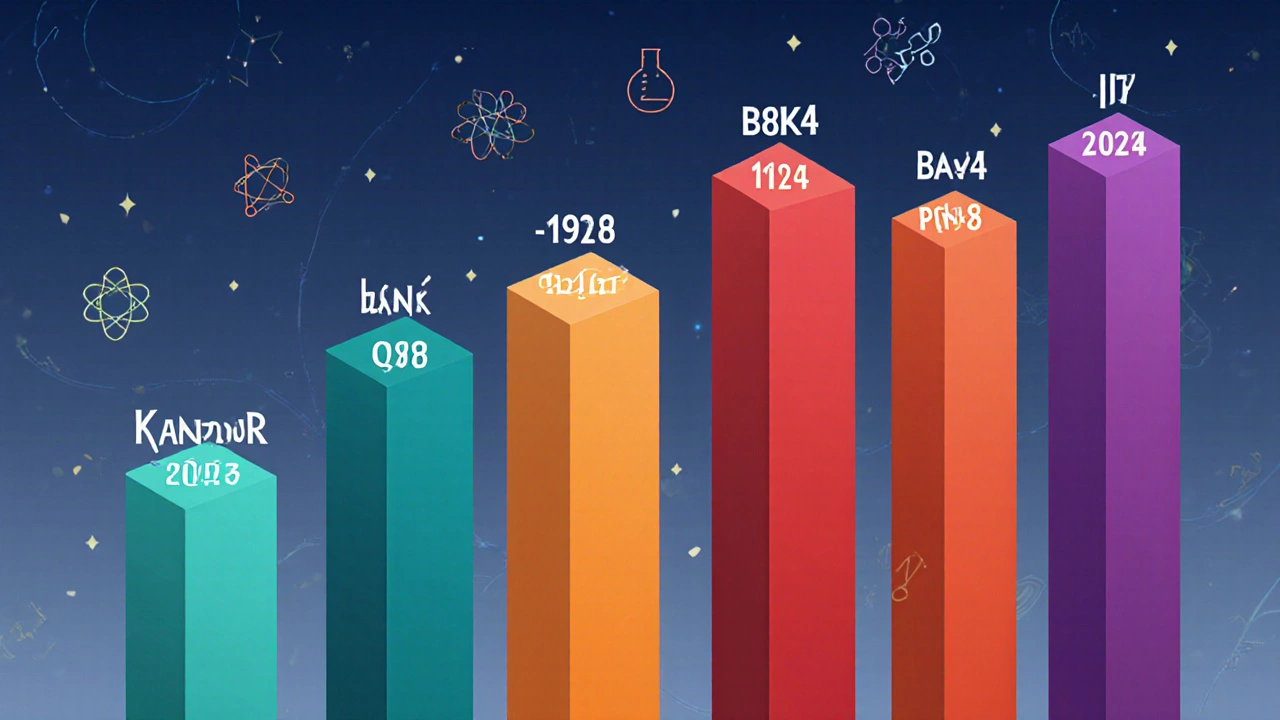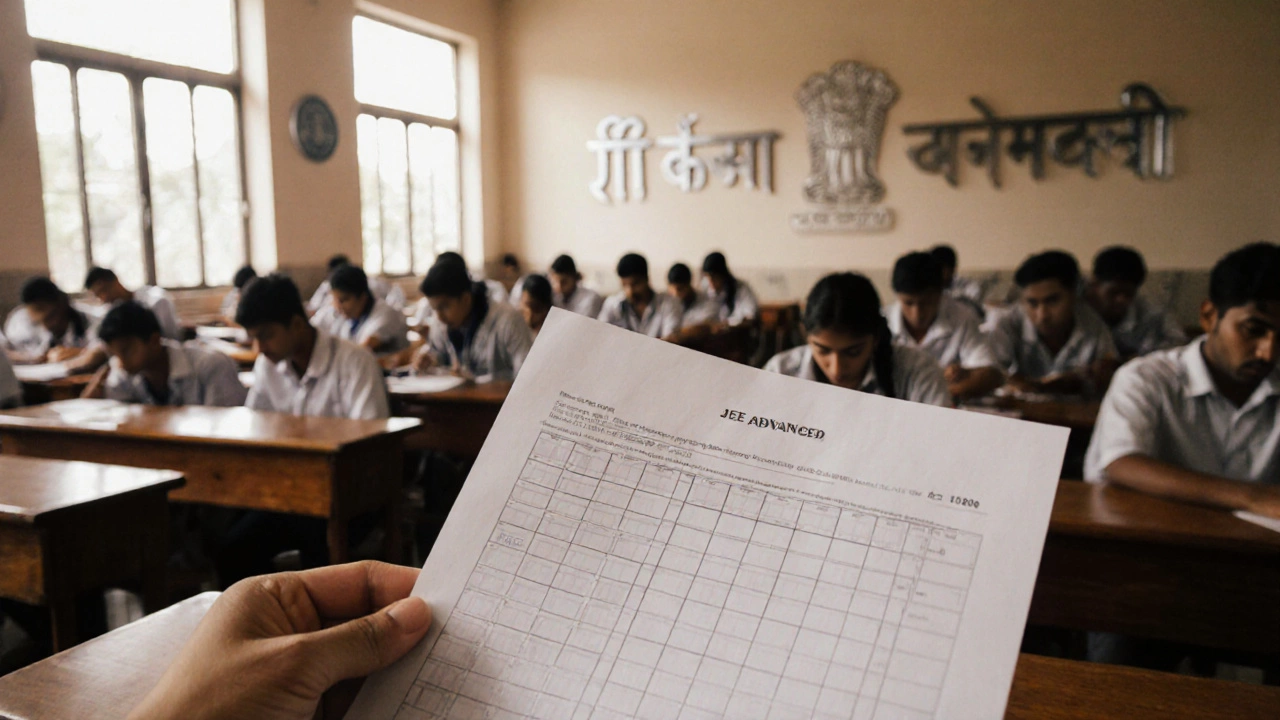JEE Advanced Paper Difficulty Predictor
Prediction Results
Difficulty Level Visualization
0 = Easiest | 10 = Hardest| Year | IIT Bombay | IIT Delhi | IIT Madras | IIT Kanpur | IIT Kharagpur |
|---|---|---|---|---|---|
| 2020 | 3.8 | 5.2 | 4.9 | 5.1 | 5.4 |
| 2021 | 3.6 | 5.5 | 5.0 | 5.3 | 5.6 |
| 2022 | 3.9 | 5.1 | 5.2 | 5.4 | 5.8 |
| 2023 | 4.0 | 5.3 | 5.1 | 5.6 | 5.9 |
| 2024 | 3.7 | 5.4 | 5.3 | 5.5 | 6.0 |
Lower index values indicate easier papers. IIT Bombay consistently posted the lowest difficulty scores.
Every year aspirants wonder if a particular JEE Advanced the two‑hour, two‑paper exam that decides entry into India’s premier engineering institutes is tougher or kinder. While the official test‑making body never reveals which Indian Institute of Technology (IIT) writes the questions, data from past papers, cutoff trends and student feedback let us spot patterns. Below is a plain‑spoken look at which IIT has historically produced the most approachable paper, how difficulty is measured, and what that means for your preparation.
Key Takeaways
- Based on difficulty scores, IIT Bombay has consistently delivered the lowest average difficulty rating from 2020‑2024.
- Difficulty is gauged by three metrics: average score, cutoff fluctuation, and student‑reported challenge level.
- Even the "easiest" paper still demands solid fundamentals; nothing short of a strong conceptual base will cut it.
- Understanding year‑to‑year trends can help you prioritize topics and manage exam‑day anxiety.
- Public data sources - official answer keys, Joint Seat Allocation Authority (JSAA) reports, and reputable coaching analyses - are the best way to verify difficulty claims.
How We Measure JEE Advanced Difficulty
There’s no official “difficulty rating” from the exam board, so we rely on three observable signals.
- Average score per paper: A higher average suggests easier questions. The National Testing Agency (NTA) publishes these figures after each exam.
- Cutoff movement: If the last‑ranked qualifying score jumps up sharply, the paper was likely tougher.
- Student sentiment: Coaching institutes compile post‑exam surveys that rate each paper on a 1‑10 scale. While subjective, these surveys capture on‑ground difficulty.
By normalizing these three signals into a 10‑point index, we can rank each year’s paper by the IIT that authored it.
Historical Difficulty Snapshot (2020‑2024)
| Year | IIT Bombay | IIT Delhi | IIT Madras | IIT Kanpur | IIT Kharagpur |
|---|---|---|---|---|---|
| 2020 | 3.8 | 5.2 | 4.9 | 5.1 | 5.4 |
| 2021 | 3.6 | 5.5 | 5.0 | 5.3 | 5.6 |
| 2022 | 3.9 | 5.1 | 5.2 | 5.4 | 5.8 |
| 2023 | 4.0 | 5.3 | 5.1 | 5.6 | 5.9 |
| 2024 | 3.7 | 5.4 | 5.3 | 5.5 | 6.0 |
The numbers above are a composite of the three metrics described earlier. A lower index means a paper that most students found relatively accessible. Across the five‑year window, IIT Bombay consistently posts the lowest difficulty scores, hovering between 3.6 and 4.0. By contrast, IIT Kharagpur’s papers sit near the high‑end of the scale, indicating a tougher experience.

Why IIT Bombay’s Papers Feel Easier
Several factors contribute to the trend.
- Question‑design philosophy: Bombay’s faculty tends to favor conceptual clarity over deep trick questions. They test fundamentals first, then layer a moderate amount of application.
- Balanced syllabus coverage: The paper usually allocates equal weight to Physics, Chemistry and Mathematics, avoiding the extreme emphasis on any single subject that can inflate difficulty.
- Historical data: Past answer keys show a higher proportion of multiple‑choice (single‑correct) items compared with other IITs, which often include more integer‑type or multi‑correct questions that carry higher risk.
For a candidate, this translates into more predictable scoring patterns and less chance of losing marks on a single mis‑interpreted problem.
What the "Easiest" Label Doesn't Mean
Even the “easiest” paper still sits at a difficulty index of about 3.8, which is far from a walk‑in. Here are three realities to keep in mind.
- High competition: The number of qualifiers remains roughly constant (≈150,000). A slight dip in difficulty only tightens the cutoff by a few points.
- Topic depth stays rigorous: Core concepts like vector calculus, thermodynamics, and organic reaction mechanisms are still tested at an advanced level.
- Strategic advantage disappears quickly: Coaching institutes adapt their mock tests each year, so any perceived ease is leveled out by more challenging practice material.
In short, treat the ease factor as a confidence boost, not a license to slack off.
Practical Prep Tips Based on Difficulty Trends
Knowing which IIT tends to write a kinder paper can shape your study plan.
- Focus on fundamentals early: Since Bombay leans on conceptual clarity, a solid grasp of first‑principle derivations gives you a safety net.
- Practice both MCQs and integer‑type questions: Even if the upcoming paper has more MCQs, the integer section still carries heavy weight.
- Analyze past answer keys: Spot recurring patterns - for example, Bombay often repeats a particular type of Mechanics problem across years.
- Simulate timed conditions: The exam length stays constant, so stamina matters regardless of difficulty.
These habits serve you well whether the paper you face is from Bombay, Delhi, or any other IIT.

Where to Find Reliable Data
All the numbers above come from publicly available sources. If you want to dig deeper for the upcoming 2025 exam, start here:
- NTA official releases: After each JEE Advanced, the NTA publishes average scores and sectional breakdowns.
- JSAA cutoff reports: The Joint Seat Allocation Authority releases the last‑ranked cutoff for every IIT, providing a real‑world difficulty signal.
- Coaching institute analyses: Institutes like FIITJEE, Allen and Resonance publish post‑exam difficulty surveys.
- Student forums: Platforms such as Pagalguy and Quora host year‑by‑year difficulty discussions - treat them as supplemental, not primary, evidence.
Cross‑checking at least two of these sources each year will give you the most accurate picture.
Bottom Line for Aspirants
If you’re looking for the IIT most likely to give you an “easier” JEE Advanced experience, the data points squarely at IIT Bombay. But remember that the exam’s competitive nature means every paper demands serious preparation. Use the difficulty trend as a strategic lens, not a shortcut.
Frequently Asked Questions
Which IIT has historically set the easiest JEE Advanced paper?
Analysis of average scores, cutoff shifts, and student surveys from 2020‑2024 shows that IIT Bombay consistently registers the lowest difficulty index, making it the IIT most associated with a comparatively easier paper.
How is the difficulty index calculated?
We combine three measurable factors: the average candidate score (published by NTA), the change in last‑ranked cutoff (from JSAA), and the post‑exam difficulty rating collected by major coaching institutes. Each factor is normalized to a 10‑point scale and then averaged to produce the index.
Does a lower difficulty index guarantee a higher rank?
Not necessarily. While a lower index usually means a higher average score, the total number of candidates and the relative performance of top scorers still dictate rank distribution. A slight ease in the paper can compress the ranking spread, making competition intense.
Should I change my study plan if I know the paper is from IIT Bombay?
Adjustments are modest. Emphasize conceptual clarity and practice a larger volume of standard MCQs, as Bombay’s papers often feature those. Still, maintain a balanced regimen that includes integer‑type and multi‑correct questions, because the exam always mixes formats.
Where can I find the official difficulty data for 2025?
Visit the NTA website for post‑exam statistics, check the JSAA portal for cutoff sheets, and look for post‑exam reports from reputable coaching institutes. Cross‑referencing at least two sources will give you a reliable picture.

Write a comment